
Telecare Market Size, Share & Trends Analysis Report By Type (Activity Monitoring, Remote Medication Management), By Region (orth America, Europe, Asia Pacific, Latin America, MEA), And Segment Forecasts, 2024 - 2030
- Report ID: GVR-4-68039-915-1
- Number of Report Pages: 100
- Format: PDF, Horizon Databook
- Historical Range: 2018 - 2022
- Forecast Period: 2024 - 2030
- Industry: Healthcare
Telecare Market Size & Trends
The global telecare market size was estimated at USD 4.39 billion in 2023 and is projected to grow at a CAGR of 5.10% from 2024 to 2030. Increasing advancement of technology to provide more efficient and improved healthcare services to patients is anticipated to drive market growth over the forecast years. For instance, in March 2023, Royal Philips unveiled Philips Virtual Care Management, offering a wide range of adaptable solutions and services for health systems, providers, payers, and employer groups to engage and support patients effectively from any location. In addition, growing awareness of maintaining physical health and increasing penetration of the internet & smartphones help accelerate market growth.
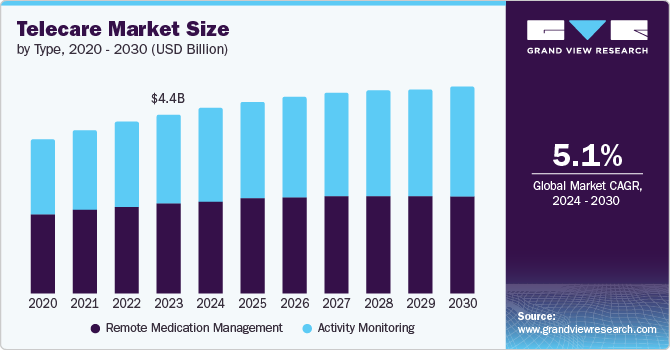
Moreover, advancements in digital health, telecommunication, and electronic health record systems contribute significantly to adopting telecare tools for extending rehabilitation, health, and wellness services. A growing number of health apps for activity monitoring and continuous improvement of the app quality by developers are also expected to boost the market growth. Telecare services help monitor the health of older adults. The digital platforms and software used by remote monitoring centers can monitor and assist older people with unusual behavior patterns or any warning signs of falls, further boosting its adoption.
Thus, the growing geriatric population worldwide is among the key factors anticipated to drive market growth. For instance, according to the World Health Organization (WHO), by 2030, one in six people will be aged over 60 years. Moreover, some telecare technologies track the environmental condition and unconsciousness of the older adult and automatically trigger the required response. These kinds of technological advancements thereby further support market growth. The market is also driven by government initiatives to promote healthcare access and reduce healthcare costs. Various governments have launched programs to encourage the adoption of telemedicine and remote patient monitoring (RPM) services.
For instance, the U.S. Centers for Medicare and Medicaid Services (CMS) has launched several initiatives to promote telemedicine adoption, including the Medicare Telehealth Program. These initiatives have created a favorable environment for telecare companies to operate and grow. Other factors driving market growth include advancements in artificial intelligence (AI) and machine learning (ML), which enable more accurate and personalized remote care services, and the increasing adoption of cloud-based solutions, which will allow seamless data exchange and storage.
Industry Dynamics
The market is moderately fragmented. While several large-scale players, such as Philips Healthcare, Medtronic, and Roche, operate in the market, many smaller and mid-sized companies specialize in specific areas of telecare, such as RPM, telemedicine platforms, and medical alert systems.
The telecare market is characterized by a high degree of innovation, driven by technological advances, changing patient needs, and the need for cost-effective solutions. It is constantly evolving, with new technologies and products emerging regularly. For example, the development of AI and machine learning (ML) enables the creation of more sophisticated RPM systems to analyze data and provide personalized insights to healthcare providers.
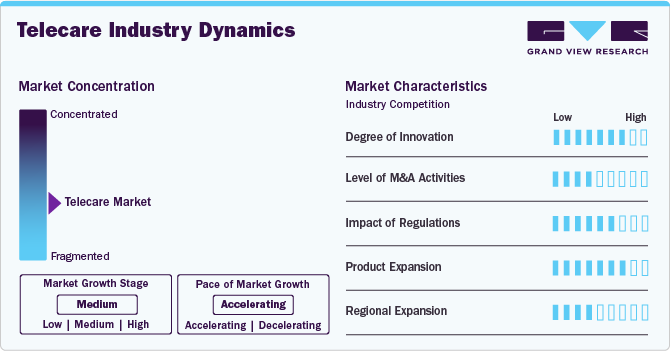
The market is heavily influenced by regulations, particularly in the healthcare and medical device sectors. Stringent regulations, such as HIPAA and FDA guidelines, ensure patient data privacy and safety. In addition, regulatory bodies, such as the European Union's Medical Device Regulation (MDR) and the Federal Communications Commission (FCC), govern the development and deployment of telecare technologies. Compliance with these regulations can be time-consuming and costly, but they also provide a framework for innovation and growth in the telecare market
The market has seen considerable M&A activities in recent years, driven by the need for scale, innovation, and expansion into new markets. Major players in the market have acquired smaller companies to gain access to new technologies, talent, and customer bases. For instance, in April 2024, OMRON Healthcare, Co., Ltd. acquired Luscii Healthtech, a digital health and remote consultation service platform industry player
The market is witnessing significant product expansion, driven by advancements in technologies, such as AI, the Internet of Things (IoT), and cloud computing. New products and services are emerging to cater to the growing demand for RPM, virtual care, and personalized health management. For instance, in January 2024, Pylo Health, a company specializing in RPM devices and a partner of Prevounce, introduced two advanced patient devices: the Pylo 900-LTE and the Pylo 200-LTE, blood pressure monitor and weight scale respectively
The market is experiencing rapid global expansion, driven by the increasing demand for remote healthcare services worldwide. Companies are expanding their operations to new regions, including emerging markets, such as Asia Pacific, Latin America, and Africa. This expansion is fueled by the need for improved healthcare access, particularly in areas with limited healthcare infrastructure. Telecare companies are partnering with local providers and governments to develop tailored solutions and address specific healthcare challenges in each region. This expansion is enabling companies to tap into new markets and increase their global footprint
Type Insights
The activity monitoring segment held the largest share in 2023 due to several factors, including the aging population, increased prevalence of chronic diseases, and technological advancements. Activity monitoring devices offer real-time tracking and analysis of individuals' movements, allowing caregivers and healthcare providers to monitor their patients' activities and well-being remotely. For instance, in October 2023, ActiGraph unveiled a revolutionary new generation of Bluetooth Smart activity monitors, the wGT3X-BT, which has wireless communication, data capture, and wear time screening capabilities. When paired with the ActiLife software platform and the ActiLife Mobile app, this innovative device offers the most advanced features in the market.
In addition, the integration of AI and ML algorithms enhances the capabilities of these devices, enabling them to detect patterns and anomalies in behavior that may indicate potential health issues or emergencies. As a result, there has been a surge in demand for activity monitoring solutions within the market, driving substantial growth and innovation in this segment.
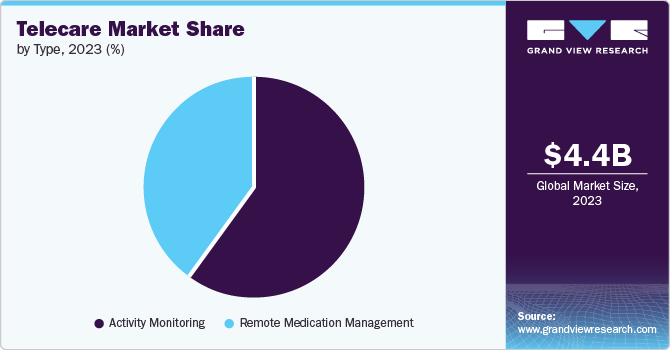
The remote medication management segment is expected to register the fastest CAGR of 7.1% from 2024 to 2030, fueled by technological advancements and increasing demand for improved healthcare access and outcomes. With the integration of smart devices and digital platforms, remote medication management solutions offer enhanced medication adherence, dosage tracking, and real-time communication between patients and healthcare providers. For instance, Garmin Malaysia launched the HRM-Fit in March 2024, a new heart rate monitor specifically designed for women. With a clip-on design, it can be easily attached to medium- and high-support sports bras for optimal comfort, ensuring precise tracking of real-time heart rate and workout information. This growth trajectory is expected to continue as healthcare systems prioritize remote monitoring and management solutions to optimize patient care and reduce healthcare costs.
Regional Insights
The North America telecare market dominated the global market and accounted for the largest share of 48.9% in 2023. This is attributed to several factors, such as the high penetration of smartphones and the internet, growing awareness among individuals to maintain physical health, and the use of remote healthcare services. In addition, the growing burden of chronic diseases coupled with the increasing geriatric population are among the major factors anticipated to drive market growth in this region. The increasing number of telecare providers and the presence of key players in the U.S. are also leading to the increased adoption of such services in the region.
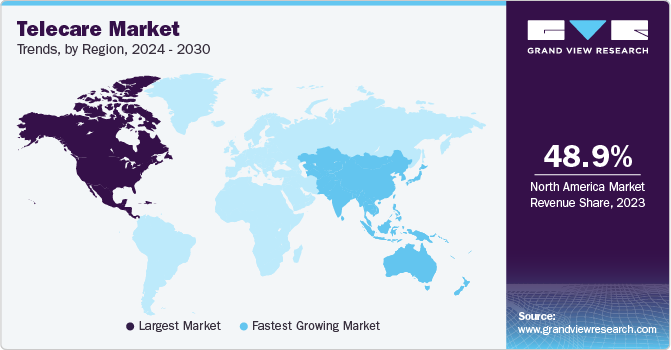
U.S. Telecare Market Trends
The telecare market in the U.S. held a significant share of 70.0% of the North America regional market in 2023 owing to the high demand for remote healthcare solutions. Regulatory oversight is provided by the Food and Drug Administration (FDA), which evaluates and approves telecare technologies through rigorous processes ensuring safety and efficacy. For instance, in March 2024, Analog Devices, Inc. announced the U.S. Food and Drug Administration's (FDA) clearance of the 510(k) application for its Sensinel Cardiopulmonary Management System, which is now commercially available. The compact wearable device is a non-invasive, remote monitoring system that captures cardiopulmonary measurements, enabling remote management of chronic diseases, such as heart failure. The approval process typically involves thorough assessments of device performance, data security, and adherence to regulatory standards. This stringent regulatory framework ensures the reliability and effectiveness of telecare solutions, fostering continued market growth.
Europe Telecare Market Trends
The Europe telecare market is experiencing significant growth, driven by advancements in technology. Innovations, such as wearable devices, remote monitoring systems, and telemedicine platforms, have revolutionized healthcare delivery, promoting independence and improving access to care for individuals across the continent. These technological advancements enable real-time health monitoring, timely interventions, and enhanced communication between patients and healthcare providers, driving market growth.
The telecare market in the UK is experiencing notable growth, fueled by the increasing adoption of remote healthcare solutions. Key players have made strategic moves to expand their market presence through acquisitions and partnerships. For instance, in November 2023, AstraZeneca announced the launch of Evinova, a cutting-edge health-tech business designed to accelerate innovation in the life sciences sector and improve patient outcomes. Evinova will focus on developing digital solutions, including RPM and digital therapeutics, with a robust pipeline of innovative products in these areas. These initiatives aim to enhance product offerings and service capabilities, catering to the growing demand for telecare services in the UK. With a focus on innovation and customer-centric solutions, these companies drive market growth and shape the future of telecare in the UK.
The Germany telecare market is expected to grow significantly over the forecast period. The market is advancing rapidly with the integration of cutting-edge technologies into telehealth platforms. For instance, in March 2023, Fractyl Health introduced the Revita+ telehealth program. This program combines behavioral recommendations with Revita treatment for Type 2 diabetes. These platforms now offer sophisticated features, such as wearable sensors for remote monitoring, AI-powered rehabilitation algorithms, and virtual reality-based therapy programs.
Asia Pacific Telecare Market Trends
The telecare market in Asia Pacific is anticipated to witness considerable growth over the forecast period, owing to the large population pool and increasing demand for remote health management services. In addition, growing internet and smartphone penetration is also anticipated to drive market growth. Moreover, increasing government initiatives to promote digital health platforms further support market growth in this region.
The China telecare market is experiencing accelerated growth, driven by cost-effective solutions that improve access to healthcare services. The integration of remote monitoring and telemedicine technologies offers efficient and affordable healthcare options for the country's growing population.
The telecare market in Japan is expected to witness significant growth due to rapid technological advancements and increasing demand for remote healthcare solutions. Innovations, such as wearable health monitoring devices, telemedicine platforms, and RPM systems, have gained popularity, offering efficient and convenient healthcare options. With a rapidly aging population and a focus on healthcare modernization, Japan continues to be a key market for telecare technologies, driving growth and innovation in the sector.
Latin America Telecare Market Trends
The Latin America telecare market is expanding rapidly, fueled by increasing demand for cost-effective healthcare solutions. With a focus on expanding the access to healthcare services in remote and underserved areas, telecare technologies are becoming increasingly popular. Innovations, such as mobile health apps, teleconsultation platforms, and wearable devices, offer efficient and affordable healthcare options, driving the growth of the telecare market across Latin America.
The telecare market in Brazil is witnessing increased demand due to factors, such as increasing adoption of digital health technologies, government initiatives to improve healthcare access, and rising chronic disease prevalence.
Middle East & Africa Telecare Market Trends
The MEA telecare market is experiencing significant growth, propelled by the increasing popularity of remote healthcare solutions. With advancements in technology and improved accessibility, telecare services are becoming more readily available across the region, catering to the growing demand for convenient and efficient healthcare options.
The telecare market in Saudi Arabia is rapidly expanding due to increasing demand for remote healthcare solutions. With a focus on enhancing access to healthcare services and improving patient outcomes, telecare options offer a better choice for individuals seeking convenient and efficient healthcare alternatives in the Kingdom.
KeyTelecare Company Insights
The competitive scenario in the telecare market is highly competitive, with key players, such as Teladoc Health, Inc.; Abbott Laboratories; Johnson and Johnson; AstraZeneca PLC; F. Hoffmann-La Roche Ltd.; Novartis AG; Bristol-Myers Squibb Company; GlaxoSmithKline plc; Merck and Co., Inc., holding significant positions. Major companies are undertaking various strategies, such as new product development, collaborations, acquisitions, mergers, and regional expansions, to serve the unmet needs of their customers.
Key Telecare Companies:
The following are the leading companies in the telecare market. These companies collectively hold the largest market share and dictate industry trends.
- Teladoc Health, Inc.
- Abbott Laboratories
- Johnson and Johnson
- AstraZeneca PLC
- F. Hoffmann-La Roche Ltd.
- Novartis AG
- Bristol-Myers Squibb Company
- GlaxoSmithKline Plc
- Merck and Co., Inc.
- Pfizer, Inc.
- Sanofi
- Samsung Electronics Co. Ltd.
- Qualcomm Technologies, Inc.
- Orange
- Google (Alphabet), Inc.
- Allscripts
- Airstrip Technologies, Inc.
- AT&T
- Apple, Inc.
Recent Developments
-
In June 2024, Ascom introduced the Activity Monitoring solution, tailored specifically for long-term care facilities. This innovative software provides a comprehensive solution for monitoring residents' health, enabling early detection and prediction of any decline in their well-being
Telecare Market Report Scope
|
Report Attribute |
Details |
|
Market size value in 2024 |
USD 4.71 billion |
|
Revenue forecast in 2030 |
USD 6.34 billion |
|
Growth rate |
CAGR of 5.10% from 2024 to 2030 |
|
Actual data |
2018 - 2023 |
|
Forecast data |
2024 - 2030 |
|
Quantitative units |
Revenue in USD million/billion and CAGR from 2024 to 2030 |
|
Report coverage |
Revenue forecast, company ranking, competitive landscape, growth factors, and trends |
|
Segments covered |
Type, region |
|
Regional scope |
North America; Europe; Asia Pacific; Latin America; MEA |
|
Country scope |
U.S.; Canada; Mexico; UK; Germany; France; Italy; Spain; Norway; Sweden; Denmark; Norway; China; Japan; India; Australia; Thailand; Korea; Brazil; Argentina; Chile; South Africa; Saudi Arabia; UAE; Kuwait |
|
Key companies profiled |
Teladoc Health, Inc.; Abbott Laboratories; Johnson and Johnson; AstraZeneca PLC; F. Hoffmann-La Roche Ltd.; Novartis AG; Bristol-Myers Squibb Company; GlaxoSmithKline Plc; Merck and Co., Inc.; Pfizer, Inc.; Sanofi; Samsung Electronics Co. Ltd.; Qualcomm Technologies, Inc.; Orange; Google (Alphabet), Inc. |
|
Customization scope |
Free report customization (equivalent up to 8 analyst working days) with purchase. Addition or alteration to country, regional & segment scope |
|
Pricing and purchase options |
Avail customized purchase options to meet your exact research needs. Explore purchase options |
Global Telecare Market Report Segmentation
This report forecasts revenue growth at global, regional, and country levels and provides an analysis of the latest trends in each of the sub-segments from 2018 to 2030. For this study, Grand View Research has segmented the telecare market report on the basis of type and region:
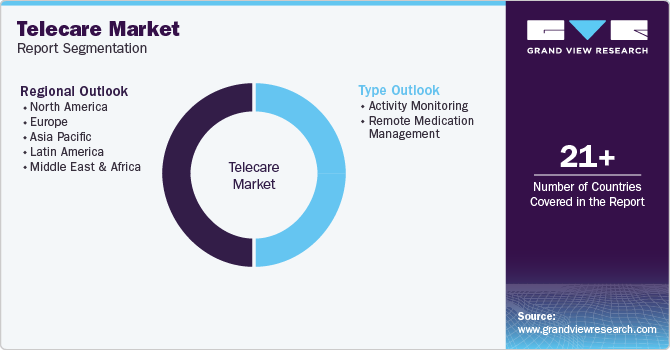
-
Telecare Type Outlook (Revenue, USD Million; 2018 - 2030)
-
Activity Monitoring
-
Remote Medication Management
-
-
Telecare Regional Outlook (Revenue, USD Million; 2018 - 2030)
-
North America
-
U.S.
-
Canada
-
Mexico
-
-
Europe
-
UK
-
Germany
-
France
-
Italy
-
Spain
-
Denmark
-
Norway
-
Sweden
-
-
Asia Pacific
-
Japan
-
China
-
India
-
Australia
-
South Korea
-
Thailand
-
-
Latin America
-
Brazil
-
Argentina
-
-
Middle East & Africa
-
South Africa
-
Saudi Arabia
-
UAE
-
Kuwait
-
-
Frequently Asked Questions About This Report
b. The global telecare market is expected to grow at a compound annual growth rate of 5.1% from 2024 to 2030 to reach USD 6.34 billion by 2030.
b. The activity monitoring segment dominated the telecare market with a share of 59.4% in 2023. This is attributable to the high adoption of telecare services for activity monitoring, especially among the elderly population.
b. Some key players operating in the telecare market include Teladoc Health, Inc., Abbott Laboratories; Johnson and Johnson; AstraZeneca PLC; F. Hoffmann-La Roche Ltd.; Novartis AG; Bristol-Myers Squibb Company; GlaxoSmithKline plc; Merck and Co., Inc.; Pfizer, Inc.; and Sanofi
b. Key factors that are driving the telecare market growth include growing awareness to maintain physical health and increasing penetration of the internet and smartphones and increasing advancement of the technology to provide more efficient and improved healthcare services to patients in their own homes.
b. The global telecare market size was estimated at USD 4.39 billion in 2023 and is expected to reach USD 4.71 billion in 2024.
We are committed towards customer satisfaction, and quality service.
"The quality of research they have done for us has been excellent."




